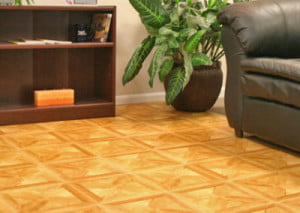
Introduction to Tiling Over Concrete: Preparing for a Successful Installation
Tiling over a concrete floor is a popular home improvement project that can significantly enhance the aesthetic appeal of your space. Concrete floors provide a sturdy, durable base for tile installation, making them an ideal choice for high-traffic areas in your home or office. However, the success of this project largely depends on the proper preparation of the concrete surface.
Before you begin, it’s crucial to ensure that the concrete floor is clean, dry, and level. Any cracks or uneven surfaces can lead to tile breakage or instability over time. If your concrete floor has been painted or sealed, you’ll need to remove these coatings to ensure the tile adhesive bonds effectively. It’s also essential to allow new concrete floors to cure fully before tiling, which typically takes around 28 days.
Moreover, it’s important to consider the type of tile you plan to install. Ceramic, porcelain, and stone tiles are all suitable for concrete floors, but each has its own specific installation requirements. For instance, stone tiles often require a special type of thin-set mortar.
Lastly, you should plan your tile layout carefully. This step can help you avoid unnecessary tile cuts and ensure a visually pleasing result. As the saying goes, “Measure twice, cut once.”
Materials and Tools Needed for Laying Tile on Concrete Floors
The right tools and materials are crucial for a successful tile installation over a concrete floor. First and foremost, you’ll need the tiles of your choice. Additionally, you’ll require a thin-set mortar suitable for your chosen tile type.
For the installation process, you’ll need a notched trowel to spread the mortar, a tile cutter or wet saw for cutting tiles, tile spacers to ensure even grout lines, and a level to check the flatness of your installation. A rubber mallet can be useful for setting the tiles into the mortar without damaging them.
To prepare the concrete floor, you may need a concrete grinder or sandpaper to remove any existing coatings or to smooth out rough areas. A vacuum cleaner is also essential for removing dust and debris.
Finally, for the finishing touches, you’ll need grout, a grout float, and a sponge for applying and cleaning up the grout. A grout sealer is also recommended to protect your new tile floor from stains and moisture.
Step-by-Step Guide: How to Install Tile Over Concrete
The first step in installing tile over concrete is to prepare the concrete floor. This involves cleaning the surface, filling any cracks, and leveling the floor if necessary. Once the floor is ready, you can begin planning your tile layout.
Next, mix your thin-set mortar according to the manufacturer’s instructions. Using your notched trowel, spread a layer of mortar onto the concrete, starting at the furthest point from the door and working your way towards it.
Place your first tile onto the mortar, pressing it down firmly and twisting it slightly to ensure a good bond. Use tile spacers to maintain consistent grout lines. Continue this process until all tiles are installed.
Allow the mortar to dry for the recommended time, usually 24 hours. Once the mortar is dry, you can remove the tile spacers and begin grouting.
Finishing Touches: Grouting and Sealing Your New Tile Floor
Grouting is the process of filling the spaces between your tiles to create a smooth, finished surface. To grout your tile floor, mix your grout according to the manufacturer’s instructions. Using a grout float, spread the grout over the tiles, pressing it into the joints.
After allowing the grout to set for a few minutes, use a damp sponge to wipe away the excess, being careful not to remove the grout from the joints. Allow the grout to dry for the recommended time, usually 24 hours.
Once the grout is dry, it’s time to seal your floor. Applying a grout sealer can help protect your new tile floor from stains and moisture, prolonging its lifespan.
In conclusion, installing tile over a concrete floor can be a rewarding DIY project that enhances the beauty and value of your space. With the right preparation, tools, and materials, you can achieve a professional-looking result that you’ll be proud of.

How to install carpet on a concrete floor.
Installing tile of a concrete floor is possible provided the necessary preparation steps are followed Paint, cutback adhesives, gypsum based fillers or levelers, sealers, or chemically treated cement substrates are unsuitable surfaces to install ceramic tile over and should be removed by non-chemical methods whenever possible. Concrete substrates must be thoroughly cleaned prior to the installation of tile. To remove dust, mop cement slab using clean water only and allow to dry completely. Very smooth concrete may be roughened up or etched using an acid based solution designed for this purpose. Make sure to fill in and float off any dips, humps, or waves on the concrete foundation using a portland cement based floor leveler. For dips, this product may be used to fill the cavity and screed off using a level or straight edge. For humps, apply the floor leveler around the base of the protrusion. Then, using the top of the hump as a guide, screed the floor around the base of the hump in a circular motion. This will help to lessen the impact the protrusion will have on your finished floor. Most Portland cement based floor levelers need to cure for at least 24 hours before the tile can be installed.
